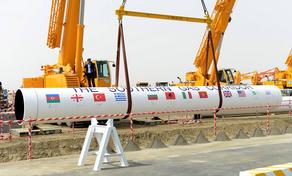
A vast majority of economists and politicians agree that the Trans-Anatolia gas pipeline, including the Southern Gas Corridor, will support Azerbaijan to step up firmly in the Turkish energy market and help Georgia increase its transit potential.
All the details of the TANAP project, with its history and economic profitability, were assessed by Doctor of Technical Science, author of more than 200 works, monographs, energy projects, scientific articles, the science of energy resources and pipeline transport fields, head of the strategic planning and projects department of Georgia's Oil and Gas Corporation, Teimuraz Gochitashvili in an interview.
In his words, TANAP represents one of the essential parts of the Southern Gas Corridor. Two compressing stations were constructed during the first phase of the project. The stations situate near Georgia's border and Eskisehir, and they are sufficient for the transportation of at least 16 bln cubic meters of gas. The project envisages the installation of five compressing stations to ensure the transport of about 20,7 bln cubic meters of gas that will be necessary allegedly by 2026. A gas reception-measuring station is in Ardahan province, Turkey, in the vicinity of Georgia's border, while two stations for issuing and receiving the gas are available in Eskisehir (Central Anatolia) and Thrace (European part of Turkey) provinces.
Teimuraz Gochitashvili says that the Trans-Anatolian Pipeline Project owner consortium shares are as follows: SOCAR 51%, BOTAS 30%, BP 12%, SOCAR Turkiye Enerji 7%.
''In 2018, from the second phase mining of the Shah-Deniz mine, the Turkish market received about one bln cubic meters of gas. In 2019, it received three bln cubic meters. Following the plan, in 2020, it will obtain about four-five bln cubic meters, while in 2020, the supplied Azerbaijani gas volume will reach six bln cubic meters. Besides, the Trans-Adriatic Pipeline (TAP) connecting the Southern Gas Corridor with the EU situates in the Greek and Albanian territories and links with Italy via the Adriatic Sea. No later than the beginning of 2021, when the TAP construction is over, the gas supply to the European markets in the Southern Gas Corridor will gradually increase and reach ten bln cubic meters. The TAP constructor consortium includes the following shares: BP – 20%, SOCAr – 20%, Snam – 20%, Fluxys -19%, Enagas -16% and Axpo - 5 %,” Gochitashvili declares.
In his words, a total of 95% of the work has been over, while the TAP total length is 545 miles. A 1.5 km-length tunnel is under construction along the Italian coast, aiming to affect the environment minimally, and it will connect the marine-sunk part of the pipeline with a land 8.2-km-length section, with the Adriatic coast. The Shah-Deniz commercial gas first flow will be provided by the end of 2020, while the supplied volume will gradually increase starting 2021. Thus, the optional gas contract-envisaged volume for Georgia will also increase. Namely, Georgia will receive about 200 mln cubic meters of gas in 2020, while the natural gas volume will reach 200 mln in 2021, 600 mln – in 2022, and Georgia tends to obtain 800 mln m3 of gas in 2024-2026 annually.
As for Georgia’s benefit from the Southern Gas Corridor, Gochitashvili states that the corridor will provide Georgia with economic and political dividends.
"Under the incumbent inter-government and host country agreements and respective deals on purchase and sale, the country receives gas from the Southern Gas Caucasian Pipeline project at a discount. Two contracts are currently in effect: on optional gas and additional gas. The first one allows us to purchase about five percent of the passed volume of gas annually. The contract term is 60 years and includes pipeline transit until 2066.
The additional gas purchase and sale contract is valid until 2026. Following the agreement, Georgia receives 500 mln cubic meters of gas annually. Before 2018, before the completion of the first phase work of TANAP and before its commissioning, Georgia was able to receive maximum 330 mln cubic meters of gas under the optional gas contract, based on the maximum supplied volume (6.6 bln m3 per annum), defined in the agreement with Turkey’s Botas of the Shah-Deniz consortium.
After the TANAP launched operation, the volume of gas passed in the Georgian territory via the Southern Gas Corridor gradually increases. By 2024-2026 and afterward, the gas volume may reach 22 bln cubic meters, which will allow Georgia to receive 1.1 bln cubic meters of gas at a discount annually. It enables Georgia to enjoy the considerable fiscal effect, as the optional gas price received from the South Caucasian Pipeline is about 2.5-3 times lower than the market price of the Russian or Azerbaijani gas in Georgia.
No similar effect was available before the commissioning of the Southern Gas Corridor, including TANAP. Political and social impacts of the development of the South Caucasian Pipeline, TANAP and TAP pipelines, are far essential. If Georgia was only a gas transit country of regional importance (it carried out the Azerbaijani gas transit to Turkey, and Russian gas transit – to Armenia), it has become an international player now.
From now on, the gas passed via Georgia's territory will play an essential role in the diversification of international, mainly the EU energy markets and improvement of the safe supply. As a result, Georgia's prospect to integrate with international progressive economic and political structures will significantly increase,'' head of the strategic planning and projects department of Georgia’s Oil and Gas Corporation, Teimuraz Gochitashvili says.































Bela Gelashvili
News Author